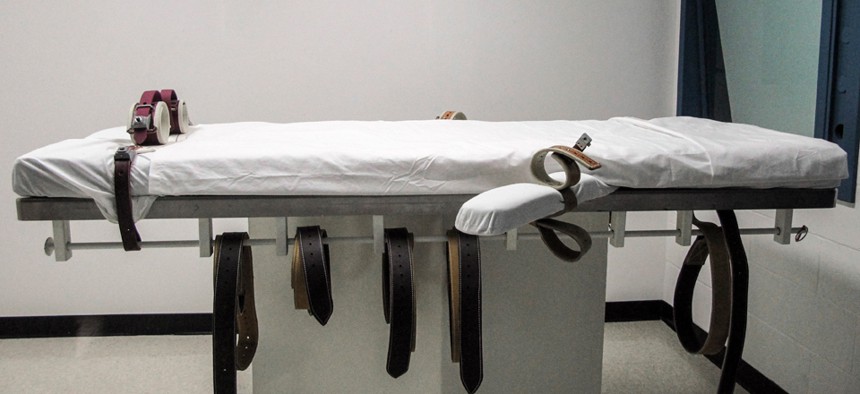Who Watches America's Executions?

Nebraska's lethal injection chamber is housed at the State Penitentiary in Lincoln, Neb. Nate Jenkins/AP file photo

Connecting state and local government leaders
A lawsuit seeks to force Oklahoma to record every death sentence it carries out and to allow witnesses present to observe.
After Joseph Wood's botched execution in July, journalists and other observers gave us grisly details about the convicted murderer's final moments. One of the reporters even counted the number of Wood's gasps—around 660 in total—as he lay on the gurney before finally dying after nearly two hours. The New York Times printed the number on its front page the next morning. During its next opportunity to rule on a lethal-injection-drug case earlier this month, all four of the Supreme Court's liberal justices voted to hear it—just one vote short of success. Now only the whims of Justice Anthony Kennedy, who has written both to save and to constrain the death penalty during his tenure, stand between the states and a review of the country's universally preferred, and increasingly troubled, execution method.
But in the botched lethal injection of Clayton Lockett in Oklahoma earlier in April, valuable observations like those in Arizona weren't independently available because of state interference. The ACLU filed a lawsuit Monday morning on behalf of the Oklahoma Observer, its editor and co-owner Arnold Hamilton, The Guardian, and freelance reporter Katie Fretland, who covered the April execution for them. When Lockett began showing clear signs of discomfort midway through the procedure, Oklahoma officials closed the blinds to the chamber and left witnesses unable to see his final moments.
"For almost 20 minutes while Clayton Lockett was dying, the assembled press and other witnesses were deprived of the right to observe the proceedings," the lawsuit alleges. "The press was also deprived of the opportunity to verify the nature and source of sounds emanating from the execution chamber, which indicated pain and suffering." This, the plaintiffs argue, violates the First Amendment's guarantee of a free press.
The suit asks the court to make two major changes to Oklahoma's execution protocol: first, to declare that the state cannot deprive witnesses of their visual or auditory access to the execution at any point once it begins, and second, to force the state to film and record all executions it performs from start to finish. In their filing, the plaintiffs discussed the importance of a media presence in the death chamber at length:
As independent witnesses to government proceedings, members of the news media provide public scrutiny, which enhances the quality and safeguards the integrity of the death penalty process. Reporting by press not associated with the condemned, the victim, or the state of Oklahoma is critical to assuring the public that they have thorough and objective facts about the execution process. Unbiased reporting is therefore necessary to the perceived and actual legitimacy of the execution process.
Public scrutiny of executions was perhaps the earliest check on the process. "In the medieval era, public executions were meant to accomplish two goals: first, to shock spectators and, second, to reaffirm divine and temporal authority," Joel F. Harrington wrote in his history of medieval executions. "A steady and reliable executioner played the pivotal role in achieving this delicate balance through his ritualized and regulated application of violence on the state's behalf." For the executioner, this balance meant beheading the condemned in a single stroke after he or she made a religiously framed journey of penance. Poorly performed executions could lead the community to lose trust in, or even retaliate against, the man who swung the axe.
In modern America, the constitutional has replaced the spiritual. Only after a laborious appeals process and a flurry of last-minute pleas for clemency can the condemned die, and even then, it must be swiftly and without pain or suffering. What defines "public" has also changed over time. Each state now has different protocols for who can observe an execution behind the prison walls. The families of both the victims and the condemned are often present. Virginia keeps a list of 20 to 30 volunteer witnesses, some of whom attend multiple times. Citizens can even participate in some states: In lieu of a full-time position, Florida pays members of the public $150 to anonymously execute one another.
But an informed reporter is often the most impartial witness present—and therefore one of the most vital. The Associated Press attends every execution in the United States by policy; Michael Graczyk, its Texas correspondent, has witnessed hundreds. (He lost precise count long ago.) "At an execution, the press serves as the public's eyes an ears," said freelance journalist Katie Fretland, a plaintiff in the lawsuit and a witness to Lockett's botched execution. "The government shouldn't be allowed to effectively blindfold us when things go wrong. The public has a right to the whole story, not a version edited by government officials." The lawsuit comes at a time of shrinking transparency in the American capital-punishment system. Many states have enacted shield laws to protect the identities of lethal-injection drug manufacturers, including unregulated compound pharmacies, to prevent boycotts and other forms of public pressure. When Oklahoma's secrecy laws came before the state supreme court in April during Clayton Lockett's appeal, state legislators triggered a constitutional crisis by threatening to impeach the justices if they did not allow the execution to proceed. The justices complied, and less than 24 hours later, Lockett died an agonizing death. The secrecy laws remain on the books. What remains is a system in which prisoners in many states are killed with drugs of uncertain provenance and administered by executioners of unknown credentials with unpredictable results. Unless the Supreme Court intervenes—and it is only one vote shy of doing so—another botched execution is inevitable. Whether anyone will be able to witness it remains disturbingly unclear.





